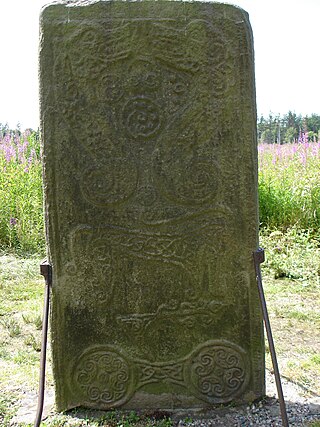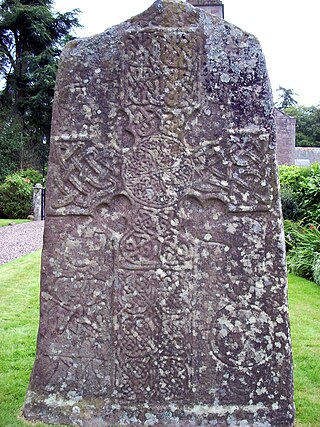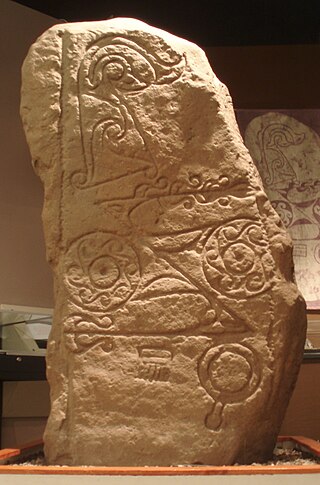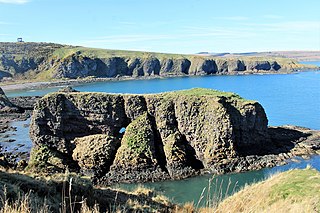Gallery
- Aberlemno 2 rear face
The triple disc is a Pictish symbol of unknown meaning, that is found on Class I and Class II Pictish stones. [1] The symbol is found in various combinations with other symbols, notably with the crescent and v-rod. The symbol is constructed from a larger central circle flanked with two smaller circles on either side. It is sometimes shown with a "bar" bisecting all three circles.

A Pictish stone is a type of monumental stele, generally carved or incised with symbols or designs. A few have ogham inscriptions. Located in Scotland, mostly north of the Clyde-Forth line and on the Eastern side of the country, these stones are the most visible remaining evidence of the Picts and are thought to date from the 6th to 9th century, a period during which the Picts became Christianized. The earlier stones have no parallels from the rest of the British Isles, but the later forms are variations within a wider Insular tradition of monumental stones such as high crosses. About 350 objects classified as Pictish stones have survived, the earlier examples of which holding by far the greatest number of surviving examples of the mysterious symbols, which have long intrigued scholars.

Clach Chairidh, alternatively named Clach Biorach, is a Class I Pictish stone located in a field near the village of Edderton in Easter Ross.

Rodney's Stone is a two-metre high Pictish cross slab now located close on the approach way to Brodie Castle, near Forres, Moray, Scotland. It was originally found nearby in the grounds of the old church of Dyke and Moy. It is classed as a Class II Pictish stone, meaning that it has a cross on one face, and symbols on the other. On the symbols face, at the top, are two fish monsters; below is a "Pictish Beast", and below that a double disc and Z-rod. On the cross face there is a cross and some animals.

The Rosemarkie Stone or Rosemarkie Cross, a Class II Pictish stone, is one of the major surviving examples of Pictish art in stone.

Painted pebbles are a class of Early Medieval artifact found in northern Scotland dating from the first millennium CE.

The Eassie Stone is a Class II Pictish stone of about the mid 8th century AD in the village of Eassie, Angus, Scotland. The stone was found in Eassie burn in the late 18th century and now resides in a purpose-built perspex building in the ruined Eassie church.

The Glamis Manse Stone, also known as Glamis 2, is a Class II Pictish stone at the village of Glamis, Angus, Scotland. Dating from the 9th century, it is located outside the Manse, close to the parish church. It is inscribed on one side with a Celtic cross and on the other with a variety of Pictish symbols. It is a scheduled monument.

The Dunnichen Stone is a class I Pictish symbol stone that was discovered in 1811 at Dunnichen, Angus. It probably dates to the 7th century AD.

The Whitecleuch Chain is a large Pictish silver chain that was found in Whitecleuch, Lanarkshire, Scotland in 1869. A high status piece, it is likely to have been worn as a choker neck ornament for ceremonial purposes. It dates from around 400 to 800 AD.

The Aberlemno Sculptured Stones are a series of five Class I and II Early Medieval standing stones found in and around the village of Aberlemno, Angus, Scotland.
The double disc is a Pictish symbol of unknown meaning that is frequently found on Class I and Class II Pictish stones, as well as on Pictish metalwork. The symbol can be found with and without an overlaid Z-rod, and in combinations of both.

The Woodwrae Stone is a Class II Pictish Stone that was found in 1819 when the foundations of the old castle at Woodwrae, Angus, Scotland were cleared. It had been reused as a floor slab in the kitchen of the castle. Following its removal from the castle, it was donated to the collection of Sir Walter Scott at Abbotsford House. It is now on display at the Museum of Scotland in Edinburgh.

The Kirriemuir Sculptured Stones are a series of Class II and III Pictish stones found in Kirriemuir, Angus, Scotland. Their existence points to Kirriemuir being an important ecclesiastical centre in the late first millennium AD.

The Invereen Stone is a Class I incised Pictish stone that was unearthed near Invereen, Inverness in 1932. It is now on display at the National Museums of Scotland, Edinburgh, Scotland.
The crescent is a Pictish symbol of unknown meaning, that is generally found in combination with an overlaid V-rod on Class I and Class II Pictish stones and infrequently without. The symbol is found in various combinations with other symbols, notably with the double disc and z-rod. The crescent with V-rod is the most frequent symbol, roughly 1 in 5, while the next most frequent symbols, the double-disc and Z-rod and Pictish beast, are half this at roughly 1 in 10.
The mirror and comb are Pictish symbols of uncertain function, found on Class I and Class II Pictish stones. The mirror, or mirror and comb, do not belong to the body of main Pictish symbols, but are used as modifiers of a symbol pair. The mirror can occur on its own, or with the comb, although the comb never occurs on its own. The mirror, or mirror and comb, occur either below the symbol pair, or beside the lower symbol.

The Dyce stones are a collection of Pictish and Early Medieval sculptured stones that are housed in a shelter in the ruined St Fergus's Chapel, Dyce, Aberdeen, Scotland. There are two larger stones, known as Dyce I and Dyce II, that bear idiomatically Pictish symbols, as well as several smaller sculptured stones.

The Ardlair Stone is a class I Pictish stone that stands in a field in Ardlair, Kennethmont, Aberdeenshire, Scotland. It is associated with a number of other stones that have been proposed by some to be the remains of a recumbent stone circle.

The Broomend of Crichie Stone is a class I Pictish stone that stands within a henge at Broomend of Crichie, Port Elphinstone, Inverurie, Aberdeenshire, Scotland. It was placed within the henge in the 19th century. The stone bears the incised symbols of the Pictish beast and the crescent and V-rod.

Dunnicaer, or Dun-na-caer, is a precipitous sea stack just off the coast of Aberdeenshire, Scotland, between Dunnottar Castle and Stonehaven. Despite the unusual difficulty of access, in 1832 Pictish symbol stones were found on the summit and 21st-century archaeology has discovered evidence of a Pictish hill fort which may have incorporated the stones in its structure. The stones may have been incised in the third or fourth centuries AD but this goes against the general archaeological view that the simplest and earliest symbol stones date from the fifth or even seventh century AD.